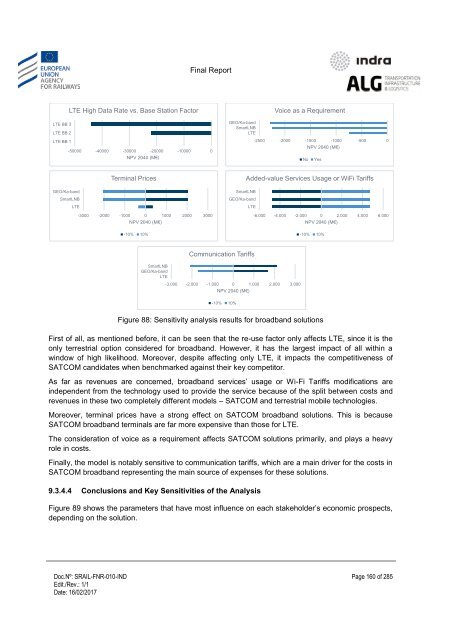Study on feasibility of SATCOM for railway communication
SRAIL-FNR-010-IND%20-%20FinalReport_v1.1_20170216
SRAIL-FNR-010-IND%20-%20FinalReport_v1.1_20170216
Create successful ePaper yourself
Turn your PDF publications into a flip-book with our unique Google optimized e-Paper software.
Final Report<br />
LTE High Data Rate vs. Base Stati<strong>on</strong> Factor<br />
LTE BB 3<br />
LTE BB 2<br />
LTE BB 1<br />
-50000 -40000 -30000 -20000 -10000 0<br />
NPV 2040 (M€)<br />
GEO/Ka-band<br />
SmartLNB<br />
LTE<br />
Voice as a Requirement<br />
-2500 -2000 -1500 -1000 -500 0<br />
NPV 2040 (M€)<br />
No<br />
Yes<br />
Terminal Prices<br />
GEO/Ka-band<br />
SmartLNB<br />
LTE<br />
-3000 -2000 -1000 0 1000 2000 3000<br />
NPV 2040 (M€)<br />
-10% 10%<br />
Added-value Services Usage or WiFi Tariffs<br />
SmartLNB<br />
GEO/Ka-band<br />
LTE<br />
-6.000 -4.000 -2.000 0 2.000 4.000 6.000<br />
NPV 2040 (M€)<br />
-10% 10%<br />
Communicati<strong>on</strong> Tariffs<br />
SmartLNB<br />
GEO/Ka-band<br />
LTE<br />
-3.000 -2.000 -1.000 0 1.000 2.000 3.000<br />
NPV 2040 (M€)<br />
-10% 10%<br />
Figure 88: Sensitivity analysis results <strong>for</strong> broadband soluti<strong>on</strong>s<br />
First <strong>of</strong> all, as menti<strong>on</strong>ed be<strong>for</strong>e, it can be seen that the re-use factor <strong>on</strong>ly affects LTE, since it is the<br />
<strong>on</strong>ly terrestrial opti<strong>on</strong> c<strong>on</strong>sidered <strong>for</strong> broadband. However, it has the largest impact <strong>of</strong> all within a<br />
window <strong>of</strong> high likelihood. Moreover, despite affecting <strong>on</strong>ly LTE, it impacts the competitiveness <strong>of</strong><br />
<strong>SATCOM</strong> candidates when benchmarked against their key competitor.<br />
As far as revenues are c<strong>on</strong>cerned, broadband services‘ usage or Wi-Fi Tariffs modificati<strong>on</strong>s are<br />
independent from the technology used to provide the service because <strong>of</strong> the split between costs and<br />
revenues in these two completely different models – <strong>SATCOM</strong> and terrestrial mobile technologies.<br />
Moreover, terminal prices have a str<strong>on</strong>g effect <strong>on</strong> <strong>SATCOM</strong> broadband soluti<strong>on</strong>s. This is because<br />
<strong>SATCOM</strong> broadband terminals are far more expensive than those <strong>for</strong> LTE.<br />
The c<strong>on</strong>siderati<strong>on</strong> <strong>of</strong> voice as a requirement affects <strong>SATCOM</strong> soluti<strong>on</strong>s primarily, and plays a heavy<br />
role in costs.<br />
Finally, the model is notably sensitive to communicati<strong>on</strong> tariffs, which are a main driver <strong>for</strong> the costs in<br />
<strong>SATCOM</strong> broadband representing the main source <strong>of</strong> expenses <strong>for</strong> these soluti<strong>on</strong>s.<br />
9.3.4.4 C<strong>on</strong>clusi<strong>on</strong>s and Key Sensitivities <strong>of</strong> the Analysis<br />
Figure 89 shows the parameters that have most influence <strong>on</strong> each stakeholder‘s ec<strong>on</strong>omic prospects,<br />
depending <strong>on</strong> the soluti<strong>on</strong>.<br />
Doc.Nº: SRAIL-FNR-010-IND<br />
Edit./Rev.: 1/1<br />
Date: 16/02/2017<br />
Page 160 <strong>of</strong> 285


